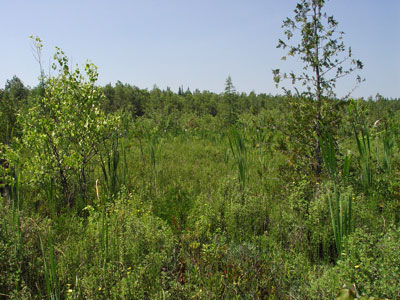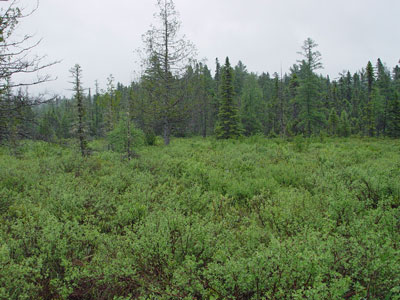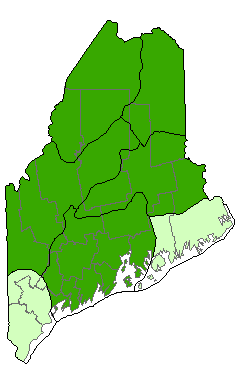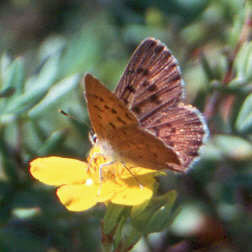DACF Home → Bureaus & Programs → Maine Natural Areas Program → Communities, Plants, and Animals → Natural Community Fact Sheets → Circumneutral Fen
Printer Friendly Fact Sheet - 1.2 MB pdf (Get a free copy of Adobe Acrobat Reader)
Circumneutral Fen
Scientific Name: Shrubby Cinquefoil - Sedge Circumneutral Fen; State Rank: S2

- Community Description
- Soil and Site Characteristics
- Diagnostics
- Similar Types
- Conservation, Wildlife and Management Considerations
- Distribution
- Characteristic Plants
- Associated Rare Plants
- Associated Rare Animals
- Examples on Conservation Lands You Can Visit
Community Description: This peatland vegetation type is dominated by sedges or grades into dwarf shrubs. Dwarf shrub and graminoid cover each range from 10-75% and are inversely proportional to each other. Sparse cedar or larch may dot the fen. Shrubs may be patchy. Dominant sedges include deer-hair sedge and slender sedge; white beak-rush is locally common. Alpine cotton-grass, with its white wispy fruiting heads, is often obvious but not abundant. Shrubby cinquefoil and bog rosemary are characteristic. Northern bog aster and marsh muhly are good indicators, as are the calciphiles livid sedge, yellow sedge, sparse-flowered sedge, and northern bog sedge. The bryoid layer is extensive, with Campylium fen moss indicative. Back to top.
Soil and Site Characteristics: These peatlands are influenced by calcium rich, circumneutral (rather than acidic) water. The substrate pH is 5.6 or higher, and remains saturated through the year. These peatlands occur in minerotrophic basins where contact with groundwater provides some nutrients to the plants. Sites are typically at lower elevations (<1000’) and usually in areas underlain by limestone or other calcareous bedrock. Back to top.

Diagnostics: Peatland vegetation is dominated by sedges or sedge/shrub mixtures including deer-hair sedge, slender sedge, and bog rosemary. Circumneutral indicators are present, such as shrubby cinquefoil, livid sedge, marsh muhly, grass-of-parnassus, and Kalm’s lobelia. Back to top.
Similar Types: Other peatland communities lack the circumneutral indicators typical of this type. Riverside Seeps have many similar species, but do not occur on peat substrate. Back to top.
Conservation, Wildlife and Management Considerations: This rare community type has been subject to few threats to date. Some examples occur on public lands and private conservation lands. Impoundment or draining would have negative impacts on hydrology and consequently on vegetation. Maintaining appropriate wetland buffers is important in minimizing the effects of adjacent land use. Degradation from recreational use has not been an issue in most places, but if disturbance, such as foot traffic, is a necessity, traversing during frozen conditions or using boardwalks can reduce impacts.
This community is inhabited by the rare Clayton’s copper butterfly, which uses shrubby cinquefoil as its sole larval host plant and primary adult nectar plant. This butterfly is found at only 14 sites worldwide, nine in Maine and five in New Brunswick. All known occurrences are in circumneutral fens with shrubby cinquefoil stands large enough to support a persistent population of the butterfly. Thaxter’s pinion moth uses sweetgale and larch as larval host plants and may be found in this community as well. Back to top.
Distribution: Most typically in the limestone regions of northern Maine, sporadically westward, eastward, and southward. (Laurentian Mixed Forest and New England - Adirondack Provinces.) Extends to northern New England and New York; Canadian distribution not well known. Landscape Pattern: Small Patch. Back to top.


Characteristic Plants: These plants are frequently found in this community type. Those with an asterisk are often diagnostic of this community.
- Sapling/shrub
- Larch*
- Northern white cedar*
- Sweetgale*
- Dwarf Shrub
- Bog rosemary*
- Leatherleaf*
- Shrubby cinquefoil*
- Sweetgale*
- Herb
- Deer-hair sedge*
- Marsh muhly
- Northern blue flag
- Northern bog aster
- Slender sedge*
- Tussock sedge*
- Bryoid
- Campyliumfen moss
- Sphagnum warnstorfii*
- Capillary sedge
- Dioecious sedge
- Livid sedge
- Low spike-moss
- Prairie sedge
- Slender-leaved sundew
- Swamp birch
- Clayton's copper
Examples on Conservation Lands You Can Visit
| Example | County |
|---|---|
| Lake Umbagog National Wildlife Refuge | Oxford Co. |
| Mattagodus Wildlife Management Area | Penobscot Co. |
| Salmon Brook Lake Bog Public Lands | Aroostook Co. |
| Woodland Bog Preserve | Aroostook Co. |
